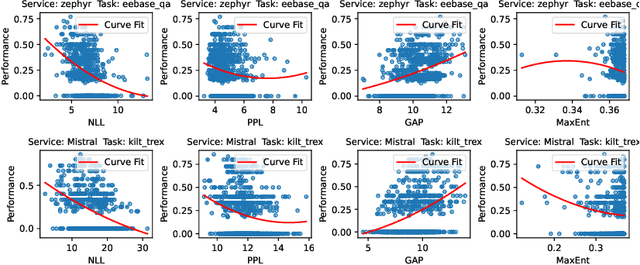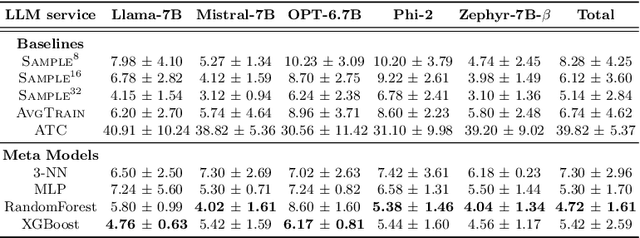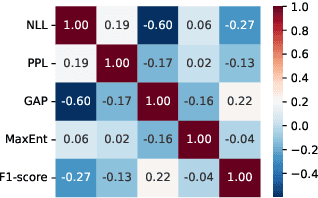Zhiying Tu
ScEdit: Script-based Assessment of Knowledge Editing
May 29, 2025Abstract:Knowledge Editing (KE) has gained increasing attention, yet current KE tasks remain relatively simple. Under current evaluation frameworks, many editing methods achieve exceptionally high scores, sometimes nearing perfection. However, few studies integrate KE into real-world application scenarios (e.g., recent interest in LLM-as-agent). To support our analysis, we introduce a novel script-based benchmark -- ScEdit (Script-based Knowledge Editing Benchmark) -- which encompasses both counterfactual and temporal edits. We integrate token-level and text-level evaluation methods, comprehensively analyzing existing KE techniques. The benchmark extends traditional fact-based ("What"-type question) evaluation to action-based ("How"-type question) evaluation. We observe that all KE methods exhibit a drop in performance on established metrics and face challenges on text-level metrics, indicating a challenging task. Our benchmark is available at https://github.com/asdfo123/ScEdit.
LFTF: Locating First and Then Fine-Tuning for Mitigating Gender Bias in Large Language Models
May 21, 2025Abstract:Nowadays, Large Language Models (LLMs) have attracted widespread attention due to their powerful performance. However, due to the unavoidable exposure to socially biased data during training, LLMs tend to exhibit social biases, particularly gender bias. To better explore and quantifying the degree of gender bias in LLMs, we propose a pair of datasets named GenBiasEval and GenHintEval, respectively. The GenBiasEval is responsible for evaluating the degree of gender bias in LLMs, accompanied by an evaluation metric named AFGB-Score (Absolutely Fair Gender Bias Score). Meanwhile, the GenHintEval is used to assess whether LLMs can provide responses consistent with prompts that contain gender hints, along with the accompanying evaluation metric UB-Score (UnBias Score). Besides, in order to mitigate gender bias in LLMs more effectively, we present the LFTF (Locating First and Then Fine-Tuning) algorithm.The algorithm first ranks specific LLM blocks by their relevance to gender bias in descending order using a metric called BMI (Block Mitigating Importance Score). Based on this ranking, the block most strongly associated with gender bias is then fine-tuned using a carefully designed loss function. Numerous experiments have shown that our proposed LFTF algorithm can significantly mitigate gender bias in LLMs while maintaining their general capabilities.
Plug-and-Play Performance Estimation for LLM Services without Relying on Labeled Data
Oct 10, 2024



Abstract:Large Language Model (LLM) services exhibit impressive capability on unlearned tasks leveraging only a few examples by in-context learning (ICL). However, the success of ICL varies depending on the task and context, leading to heterogeneous service quality. Directly estimating the performance of LLM services at each invocation can be laborious, especially requiring abundant labeled data or internal information within the LLM. This paper introduces a novel method to estimate the performance of LLM services across different tasks and contexts, which can be "plug-and-play" utilizing only a few unlabeled samples like ICL. Our findings suggest that the negative log-likelihood and perplexity derived from LLM service invocation can function as effective and significant features. Based on these features, we utilize four distinct meta-models to estimate the performance of LLM services. Our proposed method is compared against unlabeled estimation baselines across multiple LLM services and tasks. And it is experimentally applied to two scenarios, demonstrating its effectiveness in the selection and further optimization of LLM services.
Mitigating Gender Bias in Code Large Language Models via Model Editing
Oct 10, 2024Abstract:In recent years, with the maturation of large language model (LLM) technology and the emergence of high-quality programming code datasets, researchers have become increasingly confident in addressing the challenges of program synthesis automatically. However, since most of the training samples for LLMs are unscreened, it is inevitable that LLMs' performance may not align with real-world scenarios, leading to the presence of social bias. To evaluate and quantify the gender bias in code LLMs, we propose a dataset named CodeGenBias (Gender Bias in the Code Generation) and an evaluation metric called FB-Score (Factual Bias Score) based on the actual gender distribution of correlative professions. With the help of CodeGenBias and FB-Score, we evaluate and analyze the gender bias in eight mainstream Code LLMs. Previous work has demonstrated that model editing methods that perform well in knowledge editing have the potential to mitigate social bias in LLMs. Therefore, we develop a model editing approach named MG-Editing (Multi-Granularity model Editing), which includes the locating and editing phases. Our model editing method MG-Editing can be applied at five different levels of model parameter granularity: full parameters level, layer level, module level, row level, and neuron level. Extensive experiments not only demonstrate that our MG-Editing can effectively mitigate the gender bias in code LLMs while maintaining their general code generation capabilities, but also showcase its excellent generalization. At the same time, the experimental results show that, considering both the gender bias of the model and its general code generation capability, MG-Editing is most effective when applied at the row and neuron levels of granularity.
HBot: A Chatbot for Healthcare Applications in Traditional Chinese Medicine Based on Human Body 3D Visualization
Aug 01, 2024Abstract:The unique diagnosis and treatment techniques and remarkable clinical efficacy of traditional Chinese medicine (TCM) make it play an important role in the field of elderly care and healthcare, especially in the rehabilitation of some common chronic diseases of the elderly. Therefore, building a TCM chatbot for healthcare application will help users obtain consultation services in a direct and natural way. However, concepts such as acupuncture points (acupoints) and meridians involved in TCM always appear in the consultation, which cannot be displayed intuitively. To this end, we develop a \textbf{h}ealthcare chat\textbf{bot} (HBot) based on a human body model in 3D and knowledge graph, which provides conversational services such as knowledge Q\&A, prescription recommendation, moxibustion therapy recommendation, and acupoint search. When specific acupoints are involved in the conversations between user and HBot, the 3D body will jump to the corresponding acupoints and highlight them. Moreover, Hbot can also be used in training scenarios to accelerate the teaching process of TCM by intuitively displaying acupuncture points and knowledge cards. The demonstration video is available at https://www.youtube.com/watch?v=UhQhutSKkTU . Our code and dataset are publicly available at Gitee: https://gitee.com/plabrolin/interactive-3d-acup.git
Pruning via Merging: Compressing LLMs via Manifold Alignment Based Layer Merging
Jun 24, 2024Abstract:While large language models (LLMs) excel in many domains, their complexity and scale challenge deployment in resource-limited environments. Current compression techniques, such as parameter pruning, often fail to effectively utilize the knowledge from pruned parameters. To address these challenges, we propose Manifold-Based Knowledge Alignment and Layer Merging Compression (MKA), a novel approach that uses manifold learning and the Normalized Pairwise Information Bottleneck (NPIB) measure to merge similar layers, reducing model size while preserving essential performance. We evaluate MKA on multiple benchmark datasets and various LLMs. Our findings show that MKA not only preserves model performance but also achieves substantial compression ratios, outperforming traditional pruning methods. Moreover, when coupled with quantization, MKA delivers even greater compression. Specifically, on the MMLU dataset using the Llama3-8B model, MKA achieves a compression ratio of 43.75% with a minimal performance decrease of only 2.82\%. The proposed MKA method offers a resource-efficient and performance-preserving model compression technique for LLMs.
UNO Arena for Evaluating Sequential Decision-Making Capability of Large Language Models
Jun 24, 2024Abstract:Sequential decision-making refers to algorithms that take into account the dynamics of the environment, where early decisions affect subsequent decisions. With large language models (LLMs) demonstrating powerful capabilities between tasks, we can't help but ask: Can Current LLMs Effectively Make Sequential Decisions? In order to answer this question, we propose the UNO Arena based on the card game UNO to evaluate the sequential decision-making capability of LLMs and explain in detail why we choose UNO. In UNO Arena, We evaluate the sequential decision-making capability of LLMs dynamically with novel metrics based Monte Carlo methods. We set up random players, DQN-based reinforcement learning players, and LLM players (e.g. GPT-4, Gemini-pro) for comparison testing. Furthermore, in order to improve the sequential decision-making capability of LLMs, we propose the TUTRI player, which can involves having LLMs reflect their own actions wtih the summary of game history and the game strategy. Numerous experiments demonstrate that the TUTRI player achieves a notable breakthrough in the performance of sequential decision-making compared to the vanilla LLM player.
Checkpoint Merging via Bayesian Optimization in LLM Pretraining
Mar 28, 2024Abstract:The rapid proliferation of large language models (LLMs) such as GPT-4 and Gemini underscores the intense demand for resources during their training processes, posing significant challenges due to substantial computational and environmental costs. To alleviate this issue, we propose checkpoint merging in pretraining LLM. This method utilizes LLM checkpoints with shared training trajectories, and is rooted in an extensive search space exploration for the best merging weight via Bayesian optimization. Through various experiments, we demonstrate that: (1) Our proposed methodology exhibits the capacity to augment pretraining, presenting an opportunity akin to obtaining substantial benefits at minimal cost; (2) Our proposed methodology, despite requiring a given held-out dataset, still demonstrates robust generalization capabilities across diverse domains, a pivotal aspect in pretraining.
HeroNet: A Hybrid Retrieval-Generation Network for Conversational Bots
Feb 08, 2023Abstract:Using natural language, Conversational Bot offers unprecedented ways to many challenges in areas such as information searching, item recommendation, and question answering. Existing bots are usually developed through retrieval-based or generative-based approaches, yet both of them have their own advantages and disadvantages. To assemble this two approaches, we propose a hybrid retrieval-generation network (HeroNet) with the three-fold ideas: 1). To produce high-quality sentence representations, HeroNet performs multi-task learning on two subtasks: Similar Queries Discovery and Query-Response Matching. Specifically, the retrieval performance is improved while the model size is reduced by training two lightweight, task-specific adapter modules that share only one underlying T5-Encoder model. 2). By introducing adversarial training, HeroNet is able to solve both retrieval\&generation tasks simultaneously while maximizing performance of each other. 3). The retrieval results are used as prior knowledge to improve the generation performance while the generative result are scored by the discriminator and their scores are integrated into the generator's cross-entropy loss function. The experimental results on a open dataset demonstrate the effectiveness of the HeroNet and our code is available at https://github.com/TempHero/HeroNet.git
Who Should I Engage with At What Time? A Missing Event Aware Temporal Graph Neural Network
Jan 20, 2023Abstract:Temporal graph neural network has recently received significant attention due to its wide application scenarios, such as bioinformatics, knowledge graphs, and social networks. There are some temporal graph neural networks that achieve remarkable results. However, these works focus on future event prediction and are performed under the assumption that all historical events are observable. In real-world applications, events are not always observable, and estimating event time is as important as predicting future events. In this paper, we propose MTGN, a missing event-aware temporal graph neural network, which uniformly models evolving graph structure and timing of events to support predicting what will happen in the future and when it will happen.MTGN models the dynamic of both observed and missing events as two coupled temporal point processes, thereby incorporating the effects of missing events into the network. Experimental results on several real-world temporal graphs demonstrate that MTGN significantly outperforms existing methods with up to 89% and 112% more accurate time and link prediction. Code can be found on https://github.com/HIT-ICES/TNNLS-MTGN.
 Add to Chrome
Add to Chrome Add to Firefox
Add to Firefox Add to Edge
Add to Edge